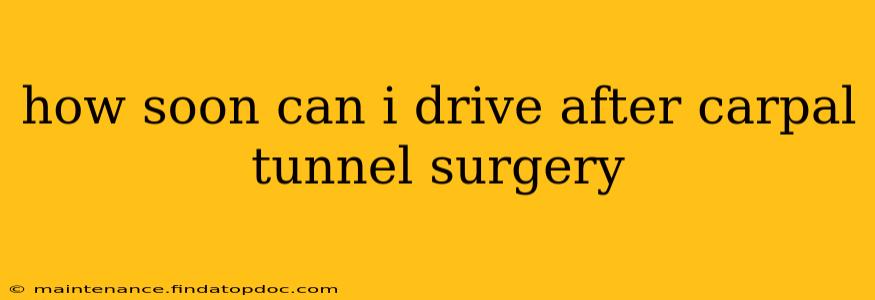Carpal tunnel surgery is a common procedure to relieve pressure on the median nerve in your wrist. While the surgery itself is often relatively quick, the recovery process varies significantly from person to person. One of the most frequently asked questions post-surgery revolves around driving: How soon can I drive after carpal tunnel surgery? The answer, unfortunately, isn't a simple one-size-fits-all.
It's crucial to remember that your surgeon's instructions should always take precedence. They'll assess your specific situation, considering factors like the type of surgery performed, your overall health, and the healing progress of your hand. Ignoring their advice could lead to complications and impede your recovery.
What Factors Influence Driving After Carpal Tunnel Surgery?
Several factors determine when you can safely return to driving after carpal tunnel surgery:
- Type of Surgery: Minimally invasive techniques generally result in faster recovery times compared to more extensive open surgeries.
- Pain and Swelling: Significant pain and swelling can significantly impair your ability to grip the steering wheel, use the pedals, and react quickly to unexpected situations.
- Medication: Pain medication can cause drowsiness or impair your reflexes, making driving unsafe.
- Strength and Range of Motion: You need sufficient strength and dexterity in your hands and wrists to safely control the vehicle.
- Suture Removal: The timing of suture removal influences the healing process and the subsequent ability to use your hands normally.
How Long Does it Typically Take to Recover?
Most people experience significant pain relief within a few days to a few weeks after carpal tunnel surgery. However, full recovery, including regaining full strength, dexterity, and sensation, can take several months. During this time, many activities, including driving, should be avoided until your surgeon deems it safe.
Can I Drive Before My Follow-Up Appointment?
Absolutely not. You should never attempt to drive before your scheduled post-operative appointment with your surgeon. This appointment is crucial for them to assess your healing process, remove stitches (if applicable), and determine when it's safe for you to resume normal activities, including driving.
What Should I Do If I'm Experiencing Pain While Driving?
If you experience any pain while attempting to drive after your surgeon has cleared you, stop immediately. Listen to your body. Pain is a signal that something isn't right. Contact your surgeon or healthcare provider to discuss your concerns.
What Are the Risks of Driving Too Soon After Surgery?
Driving before you're fully recovered poses several risks:
- Loss of Control: Pain, swelling, or reduced dexterity can impact your ability to safely control your vehicle.
- Increased Risk of Accidents: Impaired reflexes and reaction time due to medication or incomplete healing increase the likelihood of an accident.
- Delayed Healing: Straining your hand while driving can slow down the healing process and potentially lead to complications.
How Can I Prepare for Driving After Surgery?
Once your surgeon gives you the all-clear, here are a few tips to make your return to driving safer and more comfortable:
- Start with short drives: Gradually increase the duration of your driving sessions to allow your hand to adjust.
- Choose a familiar route: Avoid driving in unfamiliar areas or during peak traffic hours.
- Take breaks when needed: Rest your hand regularly to avoid fatigue and pain.
- Adjust your driving position: Ensure your seating position and steering wheel are comfortable and supportive for your wrist.
In conclusion, the answer to "How soon can I drive after carpal tunnel surgery?" is highly individualized. Prioritize your surgeon's advice and prioritize safety. Patience and adherence to their recommendations are key to a successful recovery and a safe return to driving.
